Locust Grove Antiques Market
June 28th, 2015
|
Antiques are one attraction, while the property is another. A National Historic Landmark, Locust Grove sits on 55 rolling acres south of the Ohio River, part of the original 694-acre farm established by William and Lucy Clark Croghan in 1790. Lucy’s brother was George Rogers Clark, who founded Louisville and is best remembered for his role as the Revolutionary War general whose captures of British posts in Illinois helped win the Northwest Territory from the British.
Mature trees towered over buyers and sellers at the Locust Grove Antiques Market in Louisville. The property’s semiannual fundraiser is held the last Sunday of June and September.
The mix across the grounds included Arts and Crafts furniture and contemporary folk art. A Morris chair made by Lifetime Furniture, a division of Grand Rapids Bookcase & Chair Company, having a baseball stitch, was $1750; L. & J.G. Stickley tabouret, $395; Old Hickory table, $385; and a Marvin Finn chicken, painted wood, contemporary, signed and dated ’89, was $58. They were shown by John Connelly of Dreamlight Antiques, Louisville, Kentucky.
Kentucky coin silver was readily available in a wide range of shapes and prices. This circa 1840 tablespoon, marked for James Madison Barlow, was priced at $125 by Jay Friberg, Alvena Ivy, and Nola Ivy-Friberg of Prairie Dock Antiques, Oregon, Illinois. According to Jay, Barlow moved from Kentucky to Utah, where he was the first Mormon silversmith. One Internet source (www.barlowgenealogy.com) notes, “James Madison Barlow was a gold- and silversmith, a jeweler, a watchmaker and a dentist. He was on his way to California, as the story goes, when Brigham Young persuaded him to join the Mormons and stay in Utah. He coined the first money in Utah and made many fine spoons from native silver.” |
Louisville, Kentucky
A dealer was overheard talking during a recent antiques show. “Finding good stuff isn’t hard,” he said. “Finding good stuff you can make money on is the problem.” The man was partially right, but at times there’s something else. Just ask Joseph Jarvis.
During the Locust Grove Antiques Market held June 28 in Louisville, Kentucky, Jarvis offered an 11' long store table in old red paint, priced at $895.The table had come from the studio of folk-style artist Norma Finger (1930-2010) earlier that week, but it didn’t leave without a struggle.
The studio/workspace was located in a barn on Finger’s property in Georgetown, Kentucky. The table was on the second floor, and however it got in, there was no easy way to get it out. Jarvis did what had to be done; he eased the table through a window and gently lowered it to the ground.
Sure, making money on antiques can be difficult, but sometimes just getting an item to the market is the challenge. Dealers such as Jarvis make the process look easy. A show opens, and the merchandise is there. Potential buyers seldom know the back story for any given piece.
Another table at Locust Grove came with an interesting narrative of how the antiques business works and of how often it’s a matter of a dealer being in the right place at the right time to snag a good item. Donna Brogdon of Cincinnati, Ohio, was in the middle of a 6400-mile road trip when she stumbled upon a pyrography table with a game board for a top in California. Although it was a good table, Brogdon was a bit iffy about the seller’s price, so she walked away. The next day she took a second look at the table. It was then that the dealer mentioned the Indian chief’s portrait. Brogdon was thinking, “Indian? What Indian?” when the merchant flipped up the top, converting the table to a chair and revealing the wood-burned image of the chief. Oh, and the dealer offered a 30% discount that day too. Brogdon drove back to the Midwest with the table, which was offered at Locust Grove for $495.
The latest installment of the Louisville market was rife with good merchandise that went well beyond just furniture. Regional stoneware and silver both had strong showings. Artwork and kitchenware held their own. It’s the eclectic nature of Locust Grove, where Windsor chairs and an Arts and Crafts bookcase might be in back-to-back booths and where Americana mixes with splashes of English and Continental pieces across the grounds.
Antiques are the main draw, but it doesn’t hurt that some of the finest real estate in Kentucky serves as the foundation for not only the show but for tourists and history lovers year-round. A Georgian three-story brick mansion is the backdrop for the market, and towering mature hardwoods (maples, oaks, and, of course, locust) offer refreshing shade on a hot summer afternoon. The only commotion at the June event might have been a robin on a high branch chastising showgoers early in the morning or the staccato love song of a cicada looking for a date, revving up for a rendezvous with the urgency and decibel level of a circular saw. It’s hard to imagine an antiques show with a nicer venue or one held in better, more enjoyable weather.
From their spot under a massive oak tree a stone’s throw from the main house, promoters Rod Lich and Susan Parrett gave insight into what makes Locust Grove work. Good weather helps, they noted, pointing to the 84 dealers who set up across the grounds, the total boosted slightly by fair skies and a warm day.
Among the places Lich advertised was National Public Radio. Indeed, it looked like an NPR type of crowd—intelligent adults with some extra cash to spend. A steady stream of furniture moved off the property, and shoppers were frequently seen toting smalls.
Although Locust Grove draws plenty of visitors from afar, Parrett said the show remains largely a regional attraction. “I think this is a real strong local show,” she noted. “We do get people who travel to it, but the strength is in the local people.”
The promoters also pointed out something unique; most shoppers aren’t in a hurry to leave. They tend to stay at this show longer than at many other venues, taking an extra lap through the market, visiting the used book sale in an adjacent building, touring the house, walking the lawns and fields, or having lunch under shade trees.
 There’s just something special about Locust Grove (both the historical site and the antiques show) that keeps people coming back. There’s history. There are quality antiques in a variety of prices. And on a June day pretty enough for a postcard, the weather didn’t hurt a bit.
There’s just something special about Locust Grove (both the historical site and the antiques show) that keeps people coming back. There’s history. There are quality antiques in a variety of prices. And on a June day pretty enough for a postcard, the weather didn’t hurt a bit.
The Locust Grove Antiques Market returns to the historical site on Sunday, September 27. Admission is $8 (free for children 12 and under) and includes tours of the historical house museum.
For information about the show, phone Lich at (812) 951-3454. For information about the historical site, visit (www.locustgrove.org).
|
|
|
|
|
|
|
|
Originally published in the October 2015 issue of Maine Antique Digest. © 2015 Maine Antique Digest
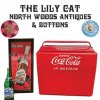

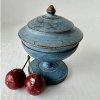


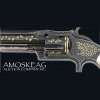


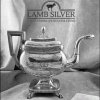
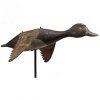



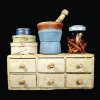

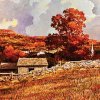

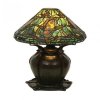
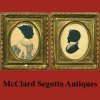




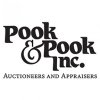
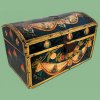






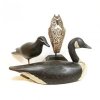
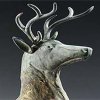



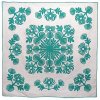






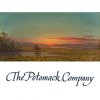





 The merchandise wasn’t all American. This French Louis XVI desk with brass trim and an inset leather writing surface was priced at $2995 by Chuck Rawlings of Bowling Green, Kentucky.
The merchandise wasn’t all American. This French Louis XVI desk with brass trim and an inset leather writing surface was priced at $2995 by Chuck Rawlings of Bowling Green, Kentucky. The game board top was good, but it was the portrait of an Indian on the opposite side that gave added oomph to this pyrography chair table. It was priced at $495 by Donna Brogdon of Cincinnati, Ohio.
The game board top was good, but it was the portrait of an Indian on the opposite side that gave added oomph to this pyrography chair table. It was priced at $495 by Donna Brogdon of Cincinnati, Ohio. Tall and hard to find, this 16-tin pie safe of poplar has layers of green and white paint. Found in central Indiana and standing 66½" high x 40½" wide, it was priced at $1250. The horse windmill weight was $395. They were offered by Tim and Charline Chambers of Missouri Plain Folk, Sikeston, Missouri.
Tall and hard to find, this 16-tin pie safe of poplar has layers of green and white paint. Found in central Indiana and standing 66½" high x 40½" wide, it was priced at $1250. The horse windmill weight was $395. They were offered by Tim and Charline Chambers of Missouri Plain Folk, Sikeston, Missouri. How do you get an 11' table out of the second floor of a barn-turned-studio? This one came out through a window. In old red paint and missing its only drawer, the table was priced at $895 by Joseph Jarvis and Lori Cox of Jarvis Antiques, Georgetown, Kentucky. The sign at the end of the table, “Open for Inspection,” painted tin with a wooden frame, sold immediately after this picture was taken.
How do you get an 11' table out of the second floor of a barn-turned-studio? This one came out through a window. In old red paint and missing its only drawer, the table was priced at $895 by Joseph Jarvis and Lori Cox of Jarvis Antiques, Georgetown, Kentucky. The sign at the end of the table, “Open for Inspection,” painted tin with a wooden frame, sold immediately after this picture was taken.







